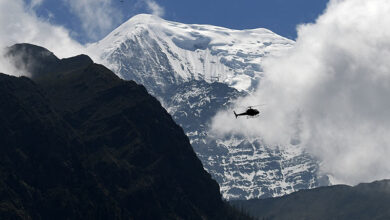
After Henri, It’s Hurricane Ida — ‘Another Katrina’: Know How Storms Are Named & What’s Next
[ad_1]
New Delhi: Hurricane Ida struck Louisiana in the US from the Gulf of Mexico on August 29, resulting in the failure of all eight transmission lines that deliver electricity to New Orleans, Louisiana’s largest city, local media reported.
A 60-year-old man, who died after a tree fell on him because of the storm, was the first person reported to be killed in the hurricane. Ida made landfall exactly 16 years after the day Hurricane Katrina struck Louisiana.
It is said to be the strongest test yet for the systems put in place since the devastating Katrina hit the US, a CNN report said, quoting experts.
Just a week earlier, on August 22, Hurricane Henri had struck the US coast of Rhode Island, near Westerly. Since the storm was downgraded, it couldn’t result in excessive damage.
Tropical cyclones are called hurricanes in the US. But how do they get their names?
Rotating Names
There are seven tropical cyclone “basins” where storms occur on a regular basis. These are the Atlantic Basin, Northeast Pacific Basin, Northwest Pacific Basin, North Indian Basin, Southwest Indian Basin, Southeast Indian or Australian Basin, and the Southwest Pacific Basin.
The World Meteorological Organization (WMO), based in Geneva, Switzerland, maintains rotating lists of names for each Tropical Cyclone Basin. A cyclone’s name is retired and replaced by another one if it is particularly deadly or costly — Katrina, for example.
According to the WMO, the next hurricane in the Atlantic Basin this season would be called Julian, followed by Kate, Larry, Mindy, Nicholas, Odette, Peter, Rose, Sam, Teresa, Victor and Wanda.
How Did The Naming System Begin?
According to the WMO, there was arbitrary naming of storms in the beginning. Later, using a list of names arranged alphabetically, meteorologists started identifying storms. Thus, a storm with a name beginning with the letter A, like Anne, would be the first storm to occur in the year. For the storms generated in the Southern Hemisphere, forecasters began using male names. This was before the end of the 1990s.
The US National Hurricane Center created some lists for naming storms, and it is from these lists that Atlantic tropical storms had begun to be named since 1953. An international committee of the WMO maintains and updates these lists.
Though only women’s names were featured in the original name lists, men’s names were introduced in 1979, alternating with the women’s names — Hurricane Henri was followed by Hurricane Ida, for example. They are in alphabetical order. Also, six lists are used in rotation and hence the 2019 list will be used again in 2025.
If a storm is extremely deadly or costly, there is a change in the list because using the same name in the future for a different storm would be inappropriate for reasons of sensitivity. If this happens, the annual meeting of the WMO Tropical Cyclone Committees called primarily to discuss many other issues strikes off the offending name and selects another to replace it. Some examples of infamous storm names include Mangkhut (Philippines, 2018), Irma and Maria (Caribbean, 2017), Haiyan (Philippines, 2013), Sandy (USA, 2012), Katrina (USA, 2005), Mitch (Honduras, 1998) and Tracy (Darwin, 1974).
Who Names The Cyclones That Hit Indian Sub-Continent?
The World Meteorological Organization, again. The WMO/Economic and Social Commission for Asia and the Pacific (ESCAP) Panel on Tropical Cyclones formulated the procedure of naming tropical cyclones in the north Indian Ocean — including Bay of Bengal and Arabian Sea — in Muscat in the year 2000.
The panel has 13 member countries from the region and the names provided by each of them are alphabetically listed, country-wise, and there is sequential use of these names listed column-wise.
The 13 countries are Bangladesh, India, Iran, Maldives, Myanmar, Oman, Pakistan, Qatar, Saudi Arabia, Sri Lanka, Thailand, United Arab Emirates and Yemen.
The 13 cyclone names continue sequentially from the first row of column one to the last row of the last column. There will be no repetition of names used for cyclones over the north Indian Ocean and the names shouldn’t be a part of the existing lists of the Regional Specialized Meteorological Centres (RSMCs) across the globe. Also, there won’t be any change in the name of a tropical cyclone that originates from South China, crosses Thailand, and emerges into the Bay of Bengal as a storm.
When tropical cyclones forming over the Bay of Bengal and the Arabian Sea reach a relevant intensity, the names are coined by the RSMC New Delhi Tropical Cyclone Center.
The current list of tropical cyclone names was adopted by the WMO/ESCAP panel in April 2020.
The 2020 list started with Nisarga, the name given by Bangladesh. The cyclone that followed May 2020’s Amphan, the last name in the previous list, made landfall in Maharashtra’s Alibaug in June last year, and was said to be one of the strongest to hit the state since 2009.
In the month of May, Cyclone Tauktae (Myanmar), originating from the Arabian Sea, made landfall in the region of Saurashtra, Gujarat, between Diu and Una. This was followed by Cyclone Yaas, in the same month, which struck the Indian states of West Bengal and Odisha.
The next cyclone from the Northern Indian Ocean will be called Gulab, because this name, provided by Pakistan, follows Yaas, given by Oman. After Gulab, the next storm will be named Shaheen (Qatar).
The first name on the list given by India was Gati (November 2020) and the next Indian name on the list is Tej.
Source link


